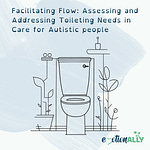When we are assessing this particular care needs there are some conditions and behaviours more commonly associated with Autistic people than in the general population that we need to take into account.
1. There is some indication that Autistic people are at increased risk of choking and coughing during eating, and that dysphagia (difficulty swallowing) may be more prevalent in Autistic populations.
2. Consider availability of “safe” and “same foods”. Safe foods are those which are predictable and can avoid sensory overload. “Same foods” are those that are eaten with regularity, often daily and preference for "sameness" can extend beyond just the type of food to include the brand, preparation method, presentation, and even the utensils used. These foods can mean a limited diet, but provide essential comfort and reduce anxiety around food. The consistency in taste, texture, and appearance of a particular brand can be a significant factor.
3. Sensory sensitivities can affect food choices and eating: the texture, taste, smell, temperature, or appearance of food can lead to strong aversions. Alternatively reduced sensitivity might lead to seeking out very strong flavours or textures. Some individuals might not recognise hunger or fullness cues due to differences in interoception (internal sense cues).
4. Avoidant/Restrictive Food Intake Disorder (ARFID): ARFID is more than just "picky eating." It involves a significant disturbance in eating with one or more of the following: significant weight loss and nutritional deficiency and their difficulties with eating are really getting in the way of their social life and how they feel about themselves. Estimates of co-occurring ARFID and autism range from 12.5% to 33.3%, compared to around 1.5% in the general population.
5. Eating Disorders (Anorexia Nervosa, Bulimia Nervosa, Binge Eating Disorder). One study suggested 20-35% of women with anorexia nervosa meet the diagnostic criteria for autism.
6. Gastrointestinal issues including IBS, IBD, constipation can affect food choices.
7. The social demands of mealtimes (e.g., conversation, sitting still, trying new foods in social settings) can be challenging for some autistic individuals, leading to anxiety and potential food refusal.
8. There is a higher prevalence of certain autoimmune diseases in Autistic populations including Celiac Disease, Diabetes (both type 1 and type 2) that affect what foods a person can safely eat.
The process of managing and maintaining nutrition
1. Consider self-awareness of bodily cues and eating habits. Do you eat regularly? Do you forget to eat? Do you ever feel full or hungry?
2. Can you make a basic meal such as a sandwich, bowl of cereal, microwave meal or instant noodles? It is worth considering whether you can follow instructions on a packet and that food can be prepared safely. Many autistic people can follow a recipe and make a meal from scratch. However, even in these cases it is worth considering risk of cuts and burns and food safety such as the amount of time needed to cook chicken so it is safe to eat.
3. Can you eat and drink independently? Here consider whether supervision is needed to avoid choking or for peg feeding etc. Can you use cutlery or lift food to your mouth without help? Are there any problems around chewing or swallowing?
4. Are you able to access and buy food either online for delivery or at the shops.
Remember
There isn't a single, clear-cut "score" or level of need that automatically triggers support. However, as a general guideline a need in managing and maintaining nutrition will meet the threshold for provision of care if it impacts the following.
• Personal dignity: being able to eat and drink in a way that feels comfortable and respects their dignity.
• Physical and mental health and emotional well-being: ensuring adequate nutrition to maintain physical and mental health and prevent malnutrition or other health issues.
• Protection from abuse and neglect: ensuring they are not at risk of harm due to an inability to manage their nutrition.
• Control over day-to-day life (including over care and support, or support and safeguarding): having choice and control over what they eat and how their nutritional needs are met.
• Suitability of living accommodation: ensuring their living environment supports their nutritional needs (e.g., access to food preparation facilities).
#careneeds #careact #nutrition #support













Share this post